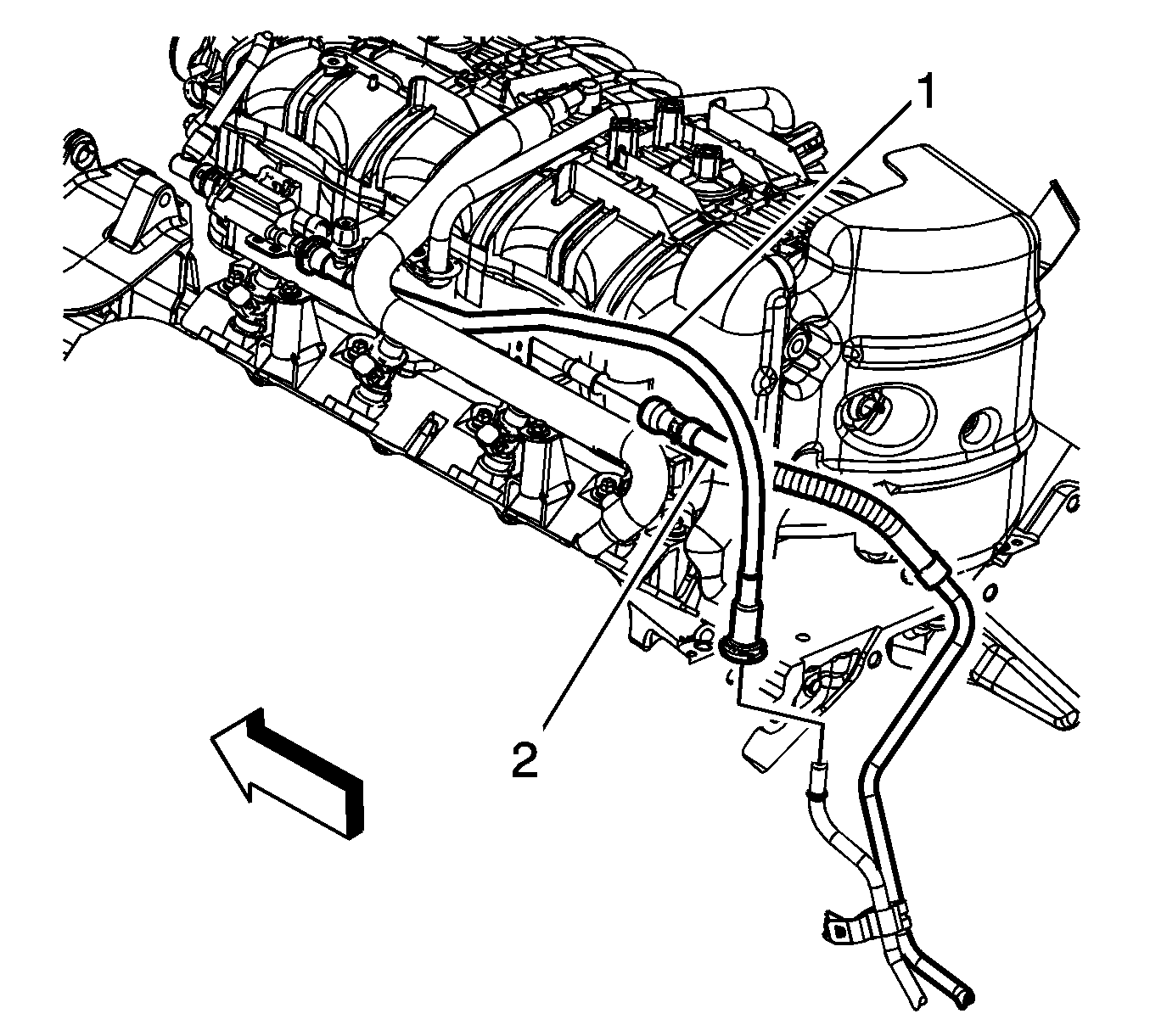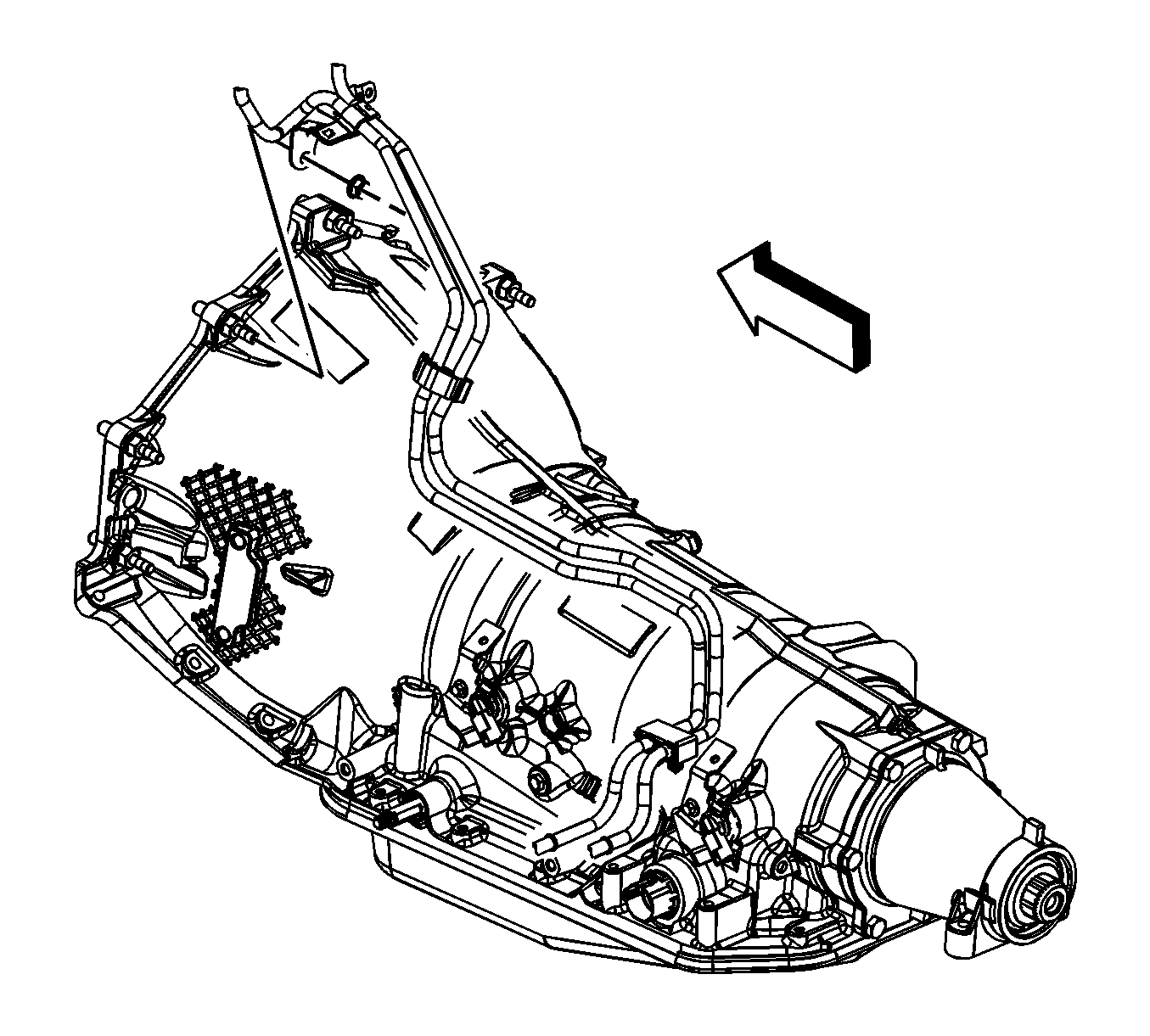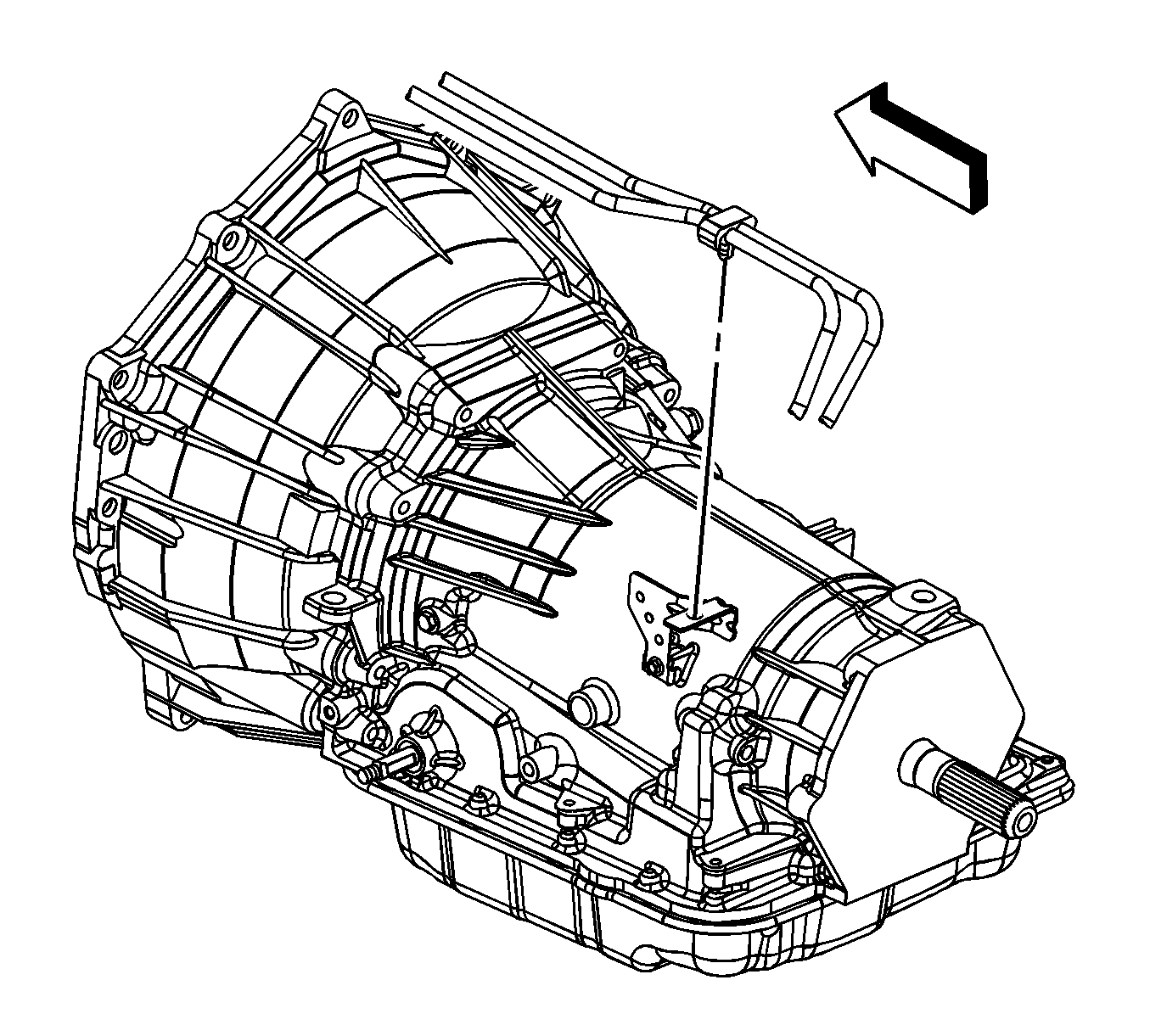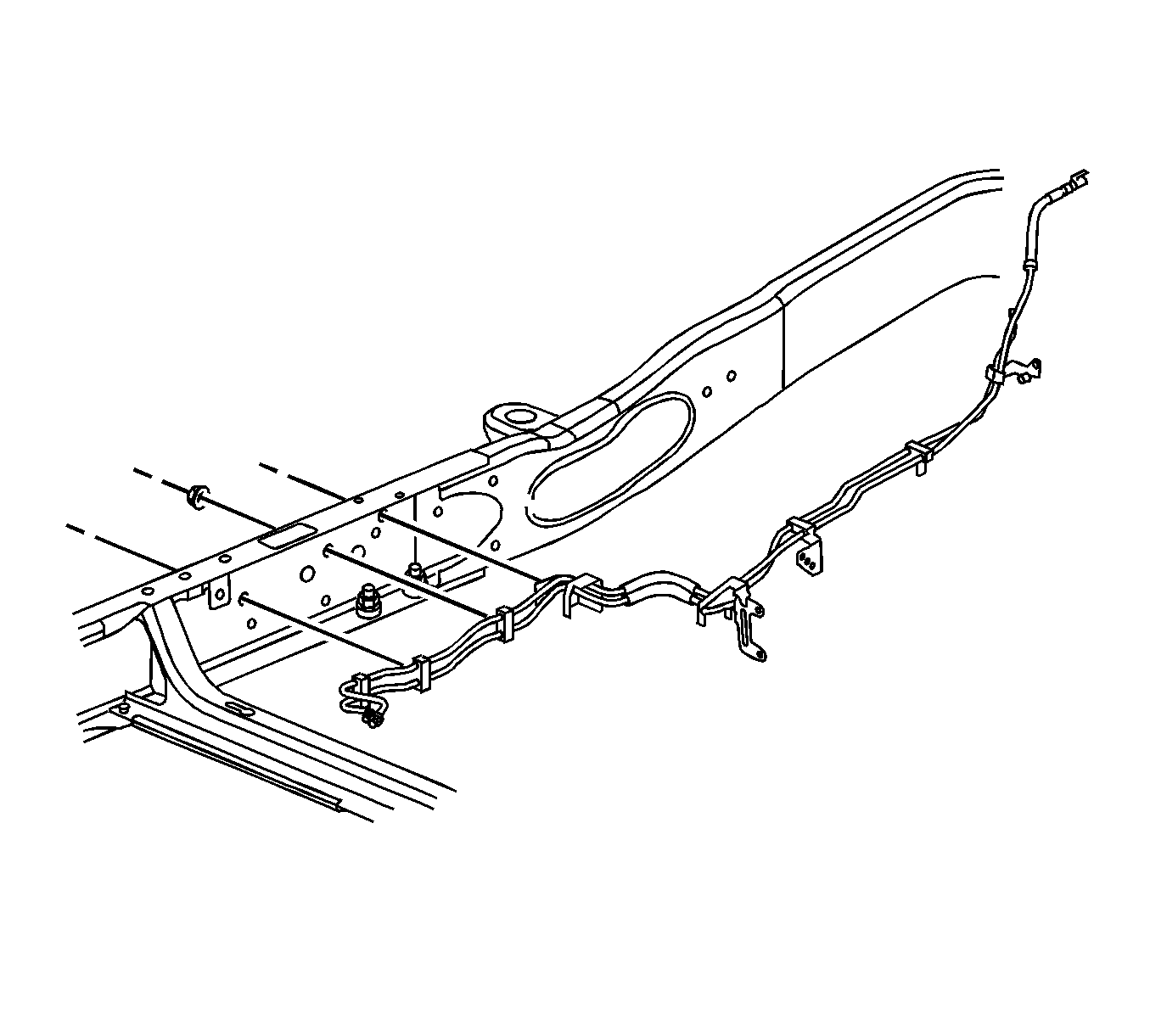For 1990-2009 cars only
Fuel Hose/Pipes Replacement - Chassis 1500 Series
Removal Procedure
Note: Clean all fuel and evaporative emission (EVAP) lines connections and surrounding areas prior to disconnecting the lines in order to avoid possible fuel and/or EVAP system contamination.
- Relieve the fuel system pressure. Refer to the Fuel Pressure Relief.
- Disconnect the engine evaporative emission (EVAP) line (1) quick connect fitting from the chassis EVAP line. Refer to Plastic Collar Quick Connect Fitting Service.
- Disconnect the fuel feed line quick connect fitting (2) from the fuel rail. Refer to Metal Collar Quick Connect Fitting Service.
- Cap the fuel rail and EVAP pipes.
- Raise and support the vehicle. Refer to Lifting and Jacking the Vehicle.
- Unbolt and reposition the front propeller shaft. Refer to Front Propeller Shaft Replacement.
- Disconnect the chassis wiring harness electrical connector (1) from the fuel pressure sensor.
- Remove the fuel pipe bracket nut from the bellhousing stud.
- Remove the fuel line clip from the bracket on the automatic transmission.
- If equipped with 4-wheel drive (4WD), remove the fuel hose/pipe clip from the bracket on the transfer case.
- Remove the fuel line bracket bolt (3).
- Disconnect the chassis EVAP line quick connect fitting (4) from the fuel tank line. Refer to Plastic Collar Quick Connect Fitting Service.
- Disconnect the fuel tank fuel feed line quick connect fitting (5) from the chassis line. Refer to Plastic Collar Quick Connect Fitting Service.
- Cap the fuel and EVAP lines in order to prevent possible fuel and/or EVAP system contamination.
- Remove the fuel/EVAP line clips from the frame and crossmember.
- Remove the fuel line bracket locator tab from the frame.
- Remove the fuel/EVAP lines from the vehicle.





Installation Procedure
- Install the fuel/EVAP lines to the vehicle.
- Install the fuel line bracket locator tab to the frame.
- Install the fuel/EVAP line clips to the frame and crossmember.
- Install the fuel line bracket bolt (3).
- Remove the caps from the fuel and EVAP lines.
- Connect the chassis EVAP line quick connect fitting (4) to the fuel tank line. Refer to Plastic Collar Quick Connect Fitting Service.
- Connect the fuel tank fuel feed line quick connect fitting (5) to the chassis line. Refer to Plastic Collar Quick Connect Fitting Service.
- If equipped with 4WD, install the fuel hose/pipe clip to the bracket on the transfer case.
- Install the fuel line clip to the bracket on the automatic transmission.
- Install the fuel pipe bracket nut to the bellhousing stud.
- Position and install the front propeller shaft. Refer to Front Propeller Shaft Replacement.
- Connect the chassis wiring harness electrical connector (1) to the fuel pressure sensor.
- Lower the vehicle.
- Remove the caps from the fuel rail and EVAP line.
- Connect the engine EVAP line (1) quick connect fitting to the chassis EVAP line. Refer to Plastic Collar Quick Connect Fitting Service.
- Connect the fuel feed line quick connect fitting (2) to the fuel rail. Refer to Metal Collar Quick Connect Fitting Service.
- Install the fuel fill cap.
- Connect the negative battery cable. Refer to Battery Negative Cable Disconnection and Connection.
- Use the following procedure in order to inspect for leaks:
- Install the intake manifold sight shield. Refer to Upper Intake Manifold Sight Shield Replacement.

Caution: Refer to Fastener Caution in the Preface section.
Tighten
Tighten the bolt to 12 N·m (106 lb in).


Tighten
Tighten the nut to 20 N·m (15 lb ft).


| 19.1. | Turn the ignition ON, with the engine OFF, for 2 seconds. |
| 19.2. | Turn the ignition OFF for 10 seconds. |
| 19.3. | Turn the ignition ON, with the engine OFF. |
| 19.4. | Inspect for fuel leaks. |
Fuel Hose/Pipes Replacement - Chassis 2500 Series
Removal Procedure
Note: Clean all fuel and evaporative emission (EVAP) line connections and surrounding areas prior to disconnecting the lines in order to avoid possible fuel and/or EVAP system contamination.
- Relieve the fuel system pressure. Refer to Fuel Pressure Relief.
- Disconnect the fuel feed pipe (2) quick connect fitting at the fuel rail. Refer to Metal Collar Quick Connect Fitting Service.
- Disconnect the EVAP line (1) quick connect fitting from the chassis line. Refer to Plastic Collar Quick Connect Fitting Service.
- Cap the fuel rail and EVAP line in order to prevent fuel/EVAP system contamination.
- Raise and support the vehicle. Refer to Lifting and Jacking the Vehicle.
- Remove the fuel pipe bracket nut.
- Remove the fuel pipe bracket from the bellhousing stud.
- Remove the fuel line clip from the bracket on the automatic transmission.
- If equipped with 4-wheel drive (4WD), remove the fuel hose/pipe clip from the bracket on the transfer case.
- Remove the fuel line bracket nuts.
- Remove the fuel/EVAP line bundle.




Installation Procedure
- Install the fuel/EVAP line bundle.
- Install the fuel line bracket nuts.
- If equipped with 4WD, install the fuel hose/pipe clip to the bracket on the transfer case.
- Install the fuel line clip to the bracket on the automatic transmission.
- Install the fuel pipe bracket to the bellhousing stud.
- Install the fuel pipe bracket nut.
- Lower the vehicle.
- Remove the caps from the fuel rail and EVAP line.
- Connect the EVAP line (1) quick connect fitting to the chassis line. Refer to Plastic Collar Quick Connect Fitting Service.
- Connect the fuel feed line (2) quick connect fitting to the fuel rail. Refer to Metal Collar Quick Connect Fitting Service.
- Install the fuel fill cap.
- Connect the negative battery cable. Refer to Battery Negative Cable Disconnection and Connection.
- Use the following procedure in order to inspect for leaks:
- Install the intake manifold sight shield. Refer to Upper Intake Manifold Sight Shield Replacement.

Caution: Refer to Fastener Caution in the Preface section.
Tighten
Tighten the bolt to 18 N·m (13 lb ft).


Tighten
Tighten the nut to 20 N·m (15 lb ft).

| 13.1. | Turn the ignition ON, with the engine OFF, for 2 seconds. |
| 13.2. | Turn the ignition OFF for 10 seconds. |
| 13.3. | Turn the ignition ON, with the engine OFF. |
| 13.4. | Inspect for fuel leaks. |
